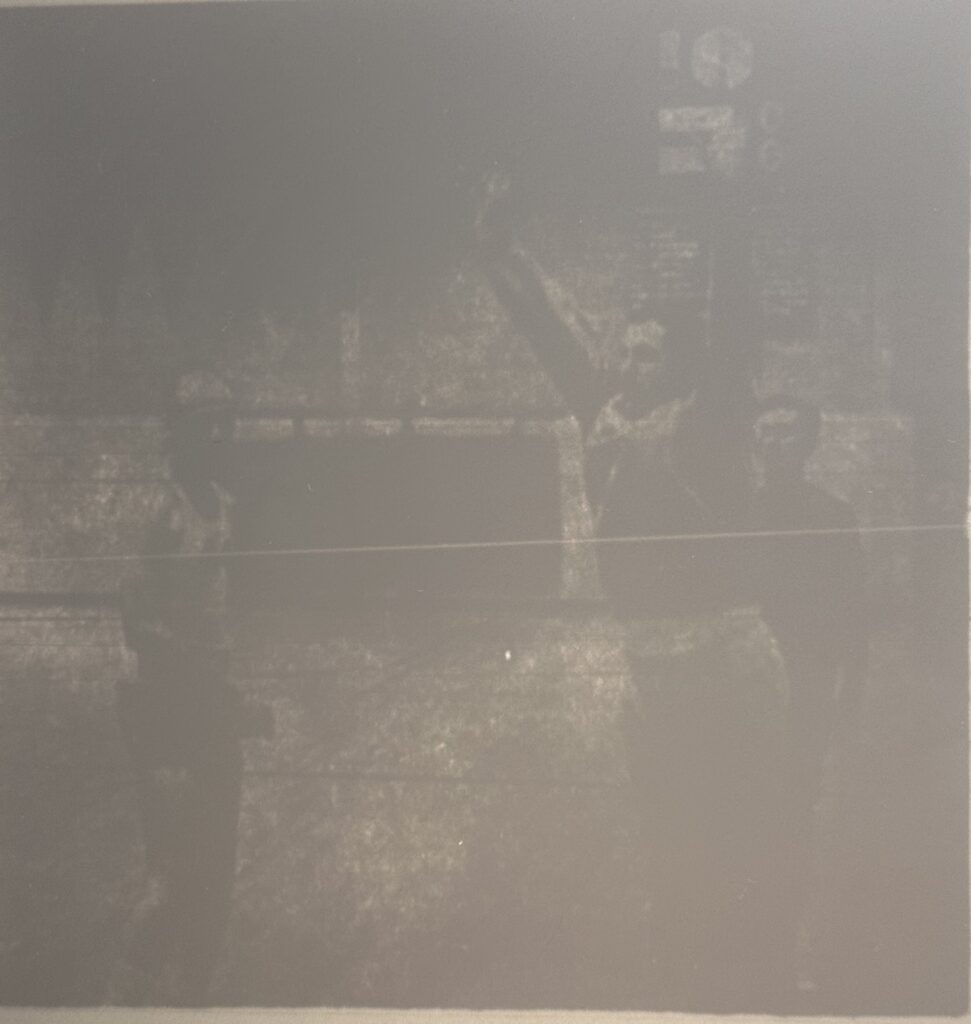The evolution of the “proper” way to shoot a basketball, a journey leading to the modern jump shot of today, did not move in a straight, clean line. There were many shooting styles, some lasting longer than others, that eventually disappeared like the dinosaurs. One of the most interesting and unusual of the extinct styles of scoring was the Centralia Kiss Shot. It was a technique used in Illinois high school basketball from at least 1939, where I found it first described in a newspaper article, and so-named in an article in 1940. But the shot could have been a part of the state’s basketball culture by at least the mid-1930s— the 1940 article touching upon the kiss shot’s use on the college level by several former Centralia, Illinois, high school players.
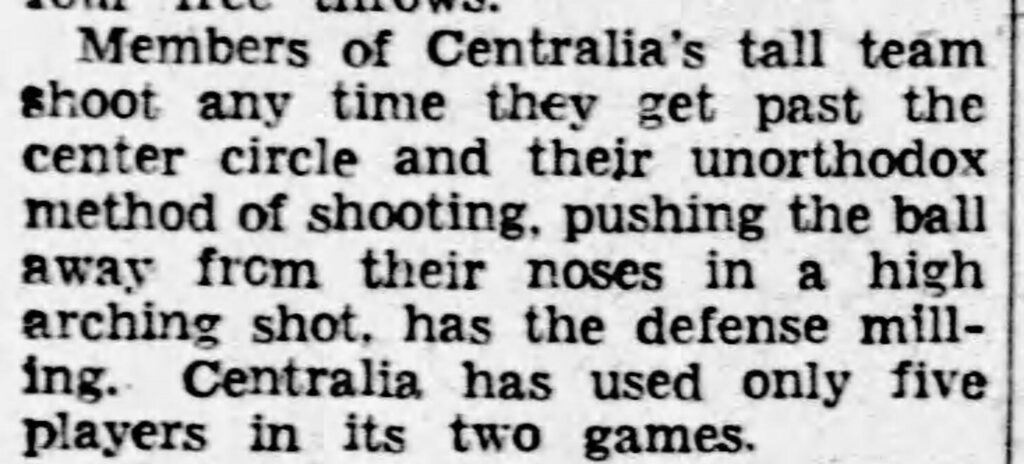
The demise of the kiss shot was a fast slide down a steep hill. By 1960, the term kiss shot was nowhere to be found in sports reports.
I became aware of and interested in the unique shooting technique when I began playing basketball on the outdoor court my dad and grandfather “constructed” in the early 1960s. All basketball courts have a magical element. My dad and grandfather fastened a small backboard and a goal to the front of our one-car garage in rural southern Illinois. And there it was, a basketball court ready to facilitate a game that was played over the world on courts large and small.
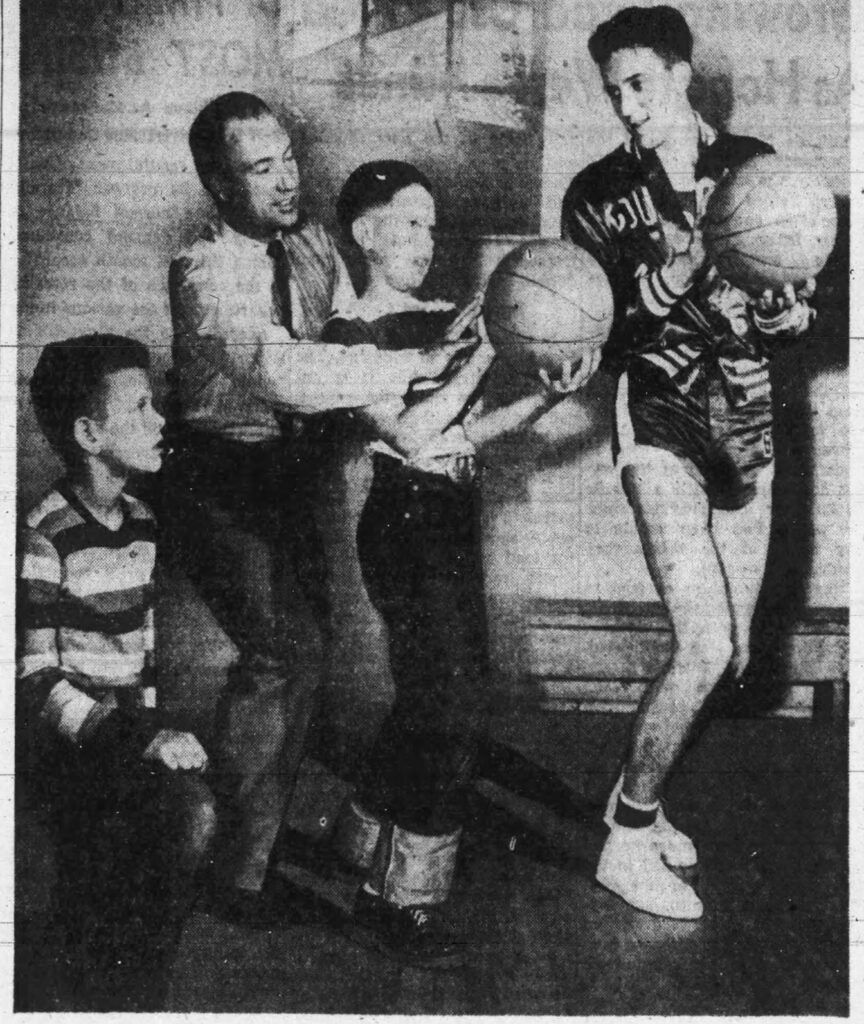
On my dirt court, my father tried to teach me old fashioned one-handed set shots and regaled me with stories of the “famous Centralia kiss shot.” When I asked him where the odd name came from, he said the shooter brushed his lips against the basketball for luck before it was released. I couldn’t tell if Dad was kidding or not.
I suspected too that Dad’s physical rendition of the kiss shot was lacking. After the ball’s release, his arms were flung wide apart, the palms and thumbs out, as if he was trying to stop a locomotive. It seemed so awkward for a technique with such a dreamy label. When I inquired about why I had never heard of the shot before, Dad just shrugged his beefy shoulders, leaving me to wonder—where did the shot come from, where did it go? Much later, I discovered that in its day, the Centralia kiss shot was a shooting style that even threatened the claim of Indiana high school basketball supremacy. The debate so raised the ire of basketball fans in both states that the only All-Star high school basketball game ever played between the two states took place in 1942 at Mt. Vernon, Illinois. I will talk about that feud in my next blog. And, ironically, it was a native Hoosier who came up with the kiss shot.
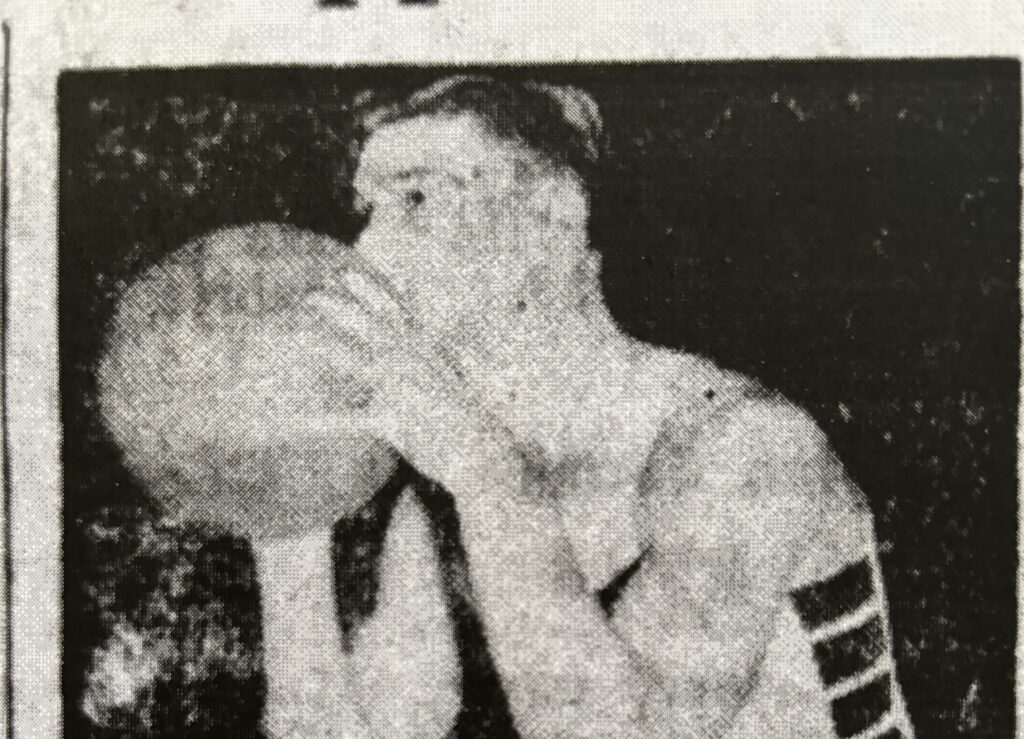
Although Arthur Trout was born and raised in Bruceville, Indiana, he began his first and only teaching/coaching job at Centralia, Illinois, in 1914. By the early 1940s, Trout was balding, rotund, and a bit eccentric. He often quoted Bible scripture and literary gems to make a point in the classroom or in the gymnasium. One time he played a first season’s basketball game with his team not yet having had a single practice. He never kept statistics. When speaking publicly, Trout always wore his coaching outfit— a wrinkled suit, white shirt, necktie, and tennis shoes. Merle Jones, long time sportswriter at the Southern Illinoisan in Carbondale, once noted in 1970 that “Trout had many quirks. Diet wise he might cook a giant pot of stew and eat the whole thing, then not eat for several meals.”
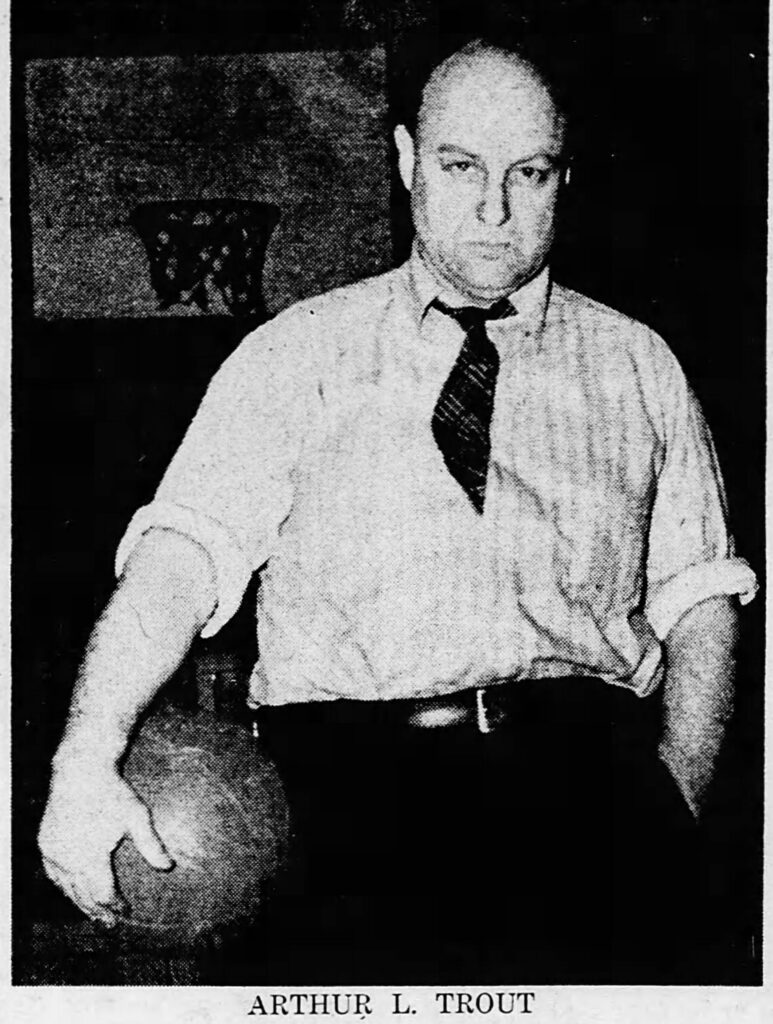
Whatever his oddities, Coach Trout developed several basketball innovations. His ideas, put into practice, made Centralia High School basketball one of the best programs in the state and the nation. One Illinois sports writer attempted to explain some of these advancements. “The A. L. Trout-coached teams operate on the theory that the team which gets the most shots is mostly likely to win, so all the players fire at will. They use a fast break and shoot from the center of the floor almost as frequently as from within the foul line. Set plays are not used.”
His most well-known innovation, however, was the “kiss shot.” For a short period, this peculiar method of scoring would become the talk of the Illinois high school basketball world and eventually the entire nation. But it would also end up being the type of basketball shooting style that lived and died during Trout’s reign as basketball coach. To understand how this odd basketball shooting style came about, and why it disappeared, a bit of back story is needed.
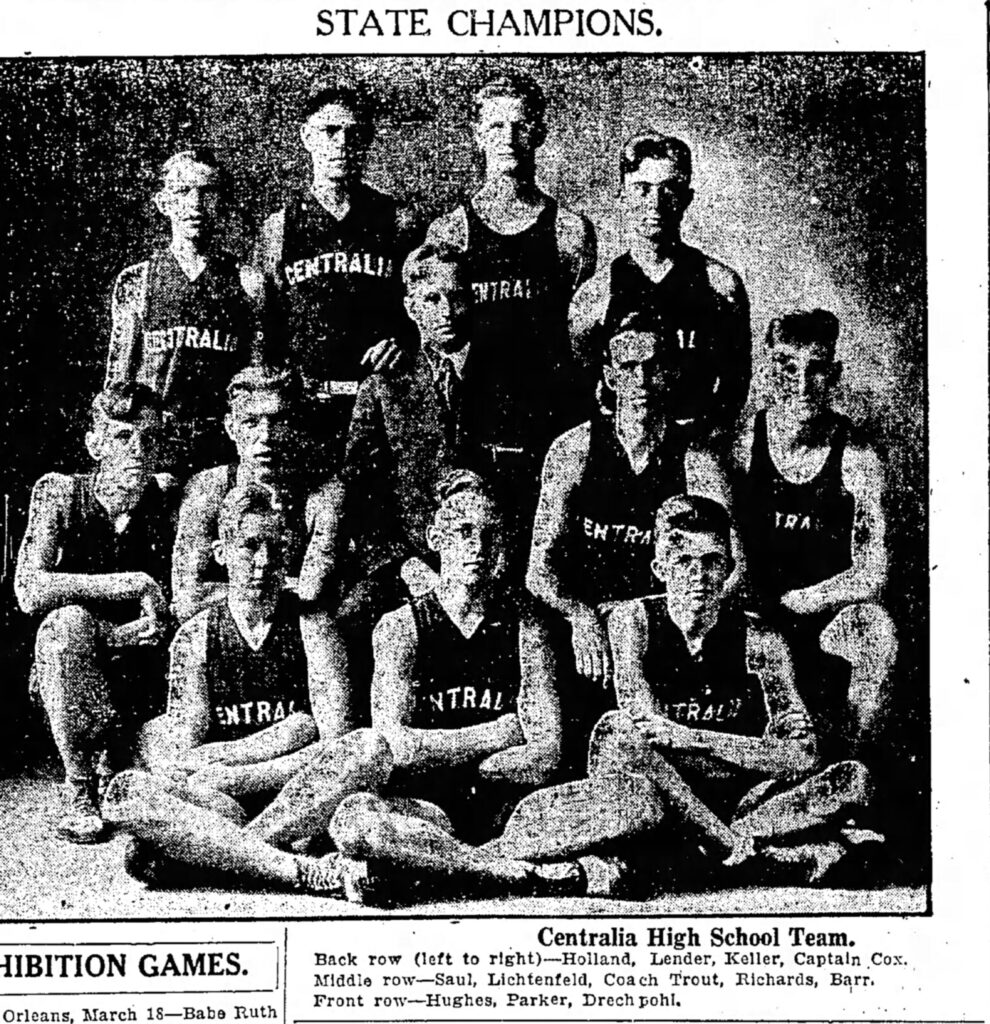
By the early 1920s, newspapers throughout the nation carried many special series explaining the important elements of successful basketball play. These narratives helped create standards so that anywhere basketball was played the game was basically the same.
The authors of these series were typically the leading coaches or players of the day, experts like Nat Holman who played for the Celtics and wrote a twelve-part series in 1923 about correct procedures for every aspect of the game. Ken Loeffler, the coach at Geneva College, did the same thing in 1934, also writing a twelve-part series on all aspects of basketball play, and Clair Bee, coach at Long Island University added his two cents worth in 1940 with yet another newspaper series.
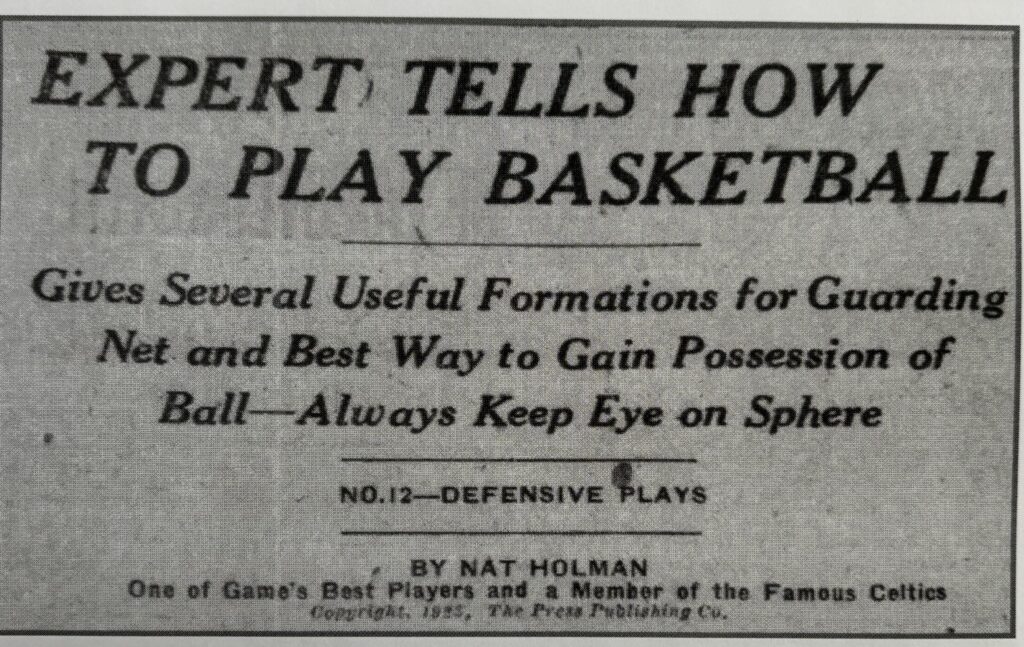
There was an early consensus that the most accurate shooting mode for basketball was made up of two basic releases— the most important being the two-handed push shot that started from mid chest and the underhand flip for foul shots and occasionally for attempts from the field. At this time, shooting a basketball was referred to as “tossing.” Soon the one-handed push shots from the chest and two-handed over the head release entered the sports scene, the latter adding great excitement for the fans.
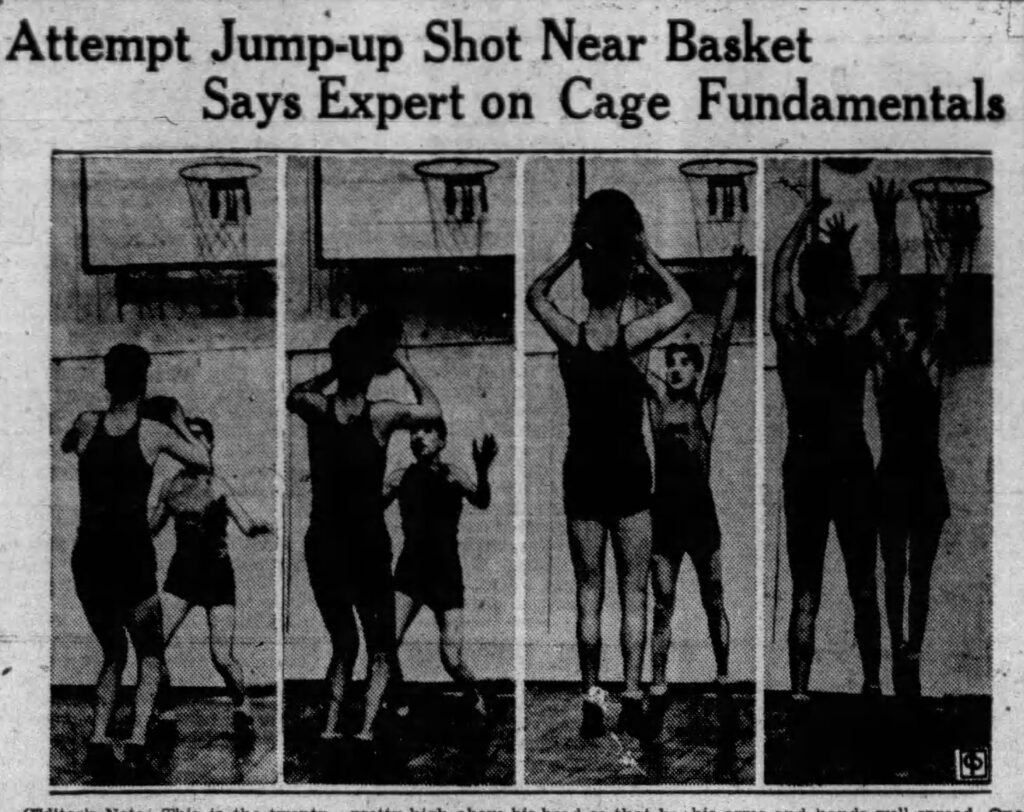
There was also a one-handed “jump shot” where a player leaped into the air while moving at a high speed in a forward direction, pushing the ball toward the basket as he went flying through the air. So-called crib shots, those taken under the basket, witnessed the player jumping and being completely extended, letting go of the ball with one hand, a movement that may have set the stage for the more modern one-hand jump shot. There were many purists, however, that believed, “To try a 1-hand shot was heresy.”
In the midst of all this were high school coaches who figured things out for themselves.
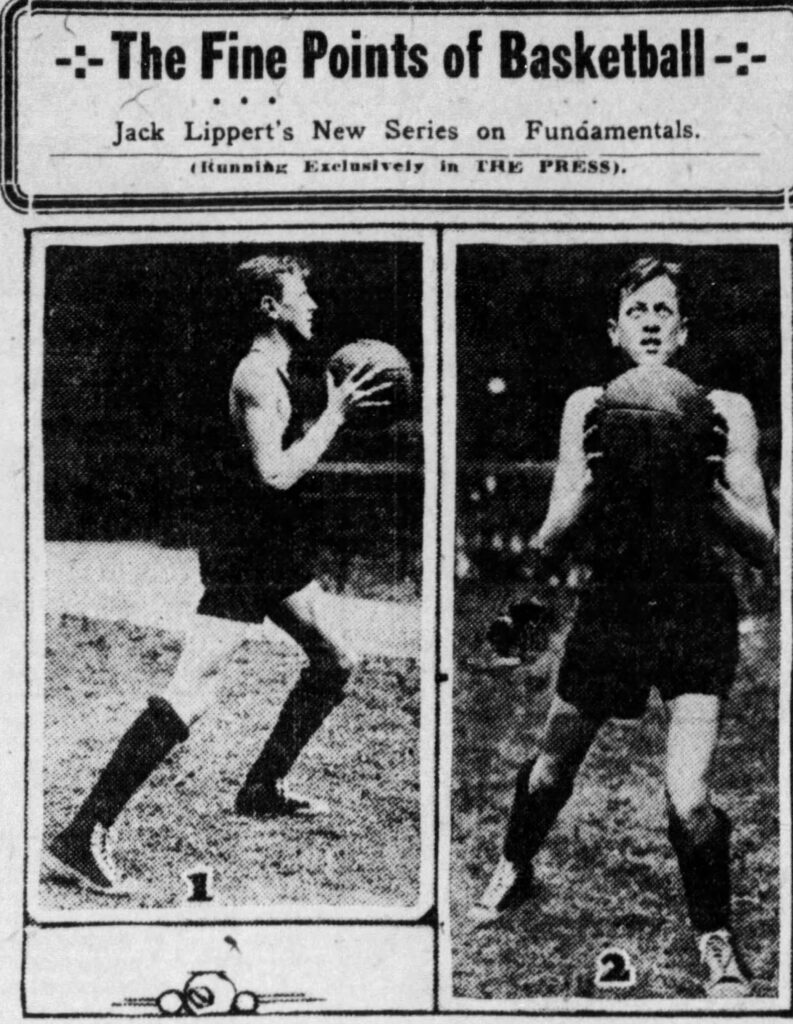
In Arthur Trout’s mind, high school players’ hands were too small to effectively shoot a one-handed shot. But he also believed the two-hand push shot lacked aim, so he invented a new way of shooting a basketball. It was a version of a two-handed push shot and was carried out with feet and knees together so the body was “centrally balanced.” The ball, however, was not held at mid chest but against the face just below eye level. The player sighted over the top of the ball, like looking down a gun barrel, shooting almost into the rafters in a high arching trajectory. His Centralia players were soon firing away from 30 to 40 feet away from the goal. To spectators, it visually seemed the player kissed the ball as it left his hands.
A successful high arching kiss shot thundering through the basket brought Centralia fans to their feet and left foes shaking their heads. Many Centralia players became so proficient with the maneuver that Coach Trout told them to shoot any time they were open once past the center line. Trout’s teams, hurling kiss shots right, left, and center, set state and national records for high school wins. But even with Trout’s Illinois high school successes, the kiss shot would never have become as nationally famous had it not been for Centralia’s Dwight “Dike” Eddelman.
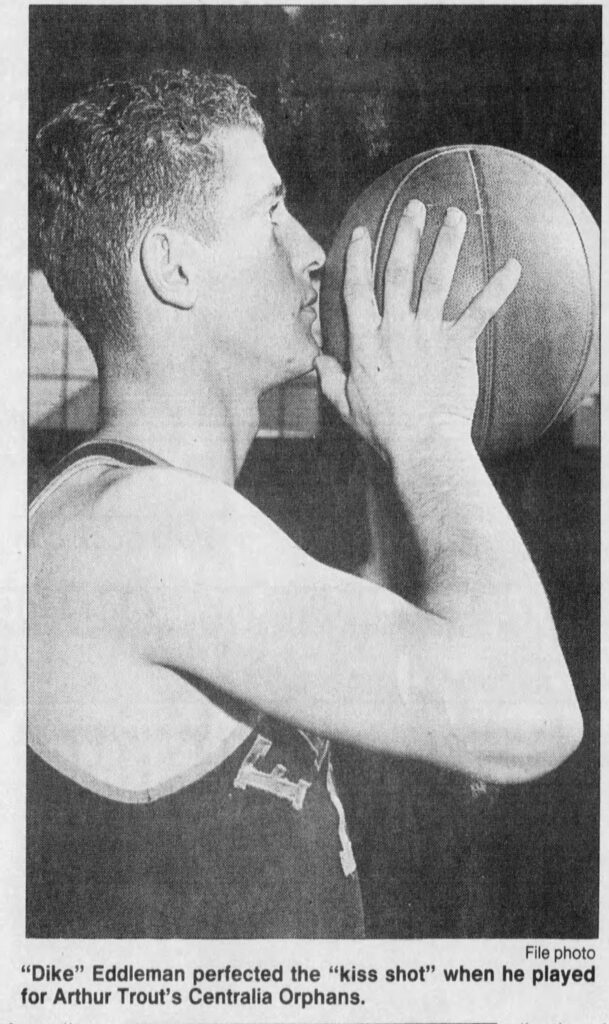
Dike Eddelmen was breaking state basketball records by his freshman year, setting a single game scoring mark in state tournament play in 1939. The next year as a sophomore he came within a whisker of winning the regular season scoring record for Illinois state play. In his junior year he started with four seniors; as a part of the “Wonder Five.” Dike’s scoring and amazing play gained national headlines. At this time, Illinois newspapers also began bragging that the state had even surpassed Indiana as having the best high school basketball in the nation, leading several Hoosier sportswriters to journey west to see Centralia and Eddelman play in March of 1941 at the Mt. Vernon, Illinois, High School gym. It turned out the sportswriters were more astounded by something other than just Eddelman.

“All five [Centralia] starters most often use the deadly ‘kiss shot,’ so named because the ball seems to brush across their lips as they let fly their high, arching loopers,” one of the reporters explained the next day. Another wrote, “Coach Trout’s great success this year is teamwork and the aggressive play of the five boys. They all shoot alike, high arching shots which start face high and disappear in the rafters, only to come swishing down again in the nets. You see very few one-hand push shots, the drive-in kind. But they employ that offense if they want. They shoot them long and then go in for the rebound, if there are any.”
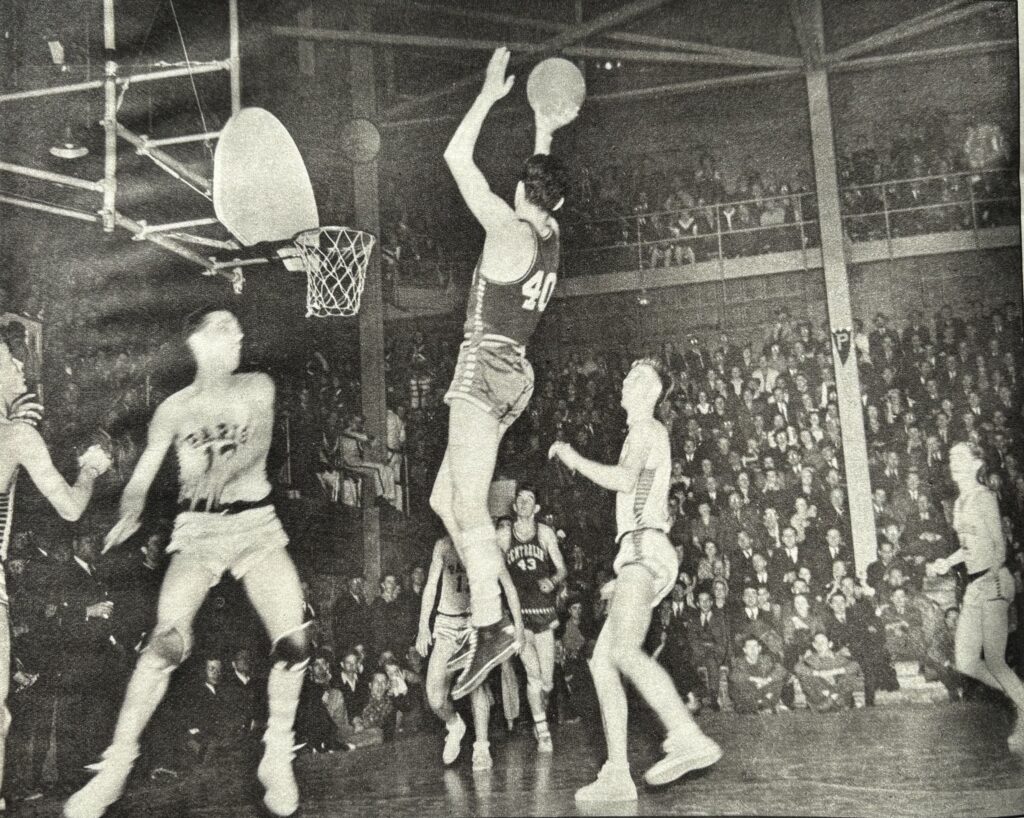
Centralia lost in the semi-final round of the state tournament in 1941. “The biggest upset in the tournament’s history,” claimed one newspaper. The next season Trout’s squad went all the way, winning the state championship. Eddelman’s achievements during that year made him a god in Illinois and eventually in the region and the nation. Sportswriters trekked to Illinois from as far away as New York City to interview the humble young man. A St. Louis paper carried six long articles about the Centralia lad that were featured in six weekend editions. Look magazine carried a four-page spread featuring Dike Eddelman, one titled “High School Hero.” All these articles emphasized the kiss shot as being fundamental to Dike and the team’s successes.
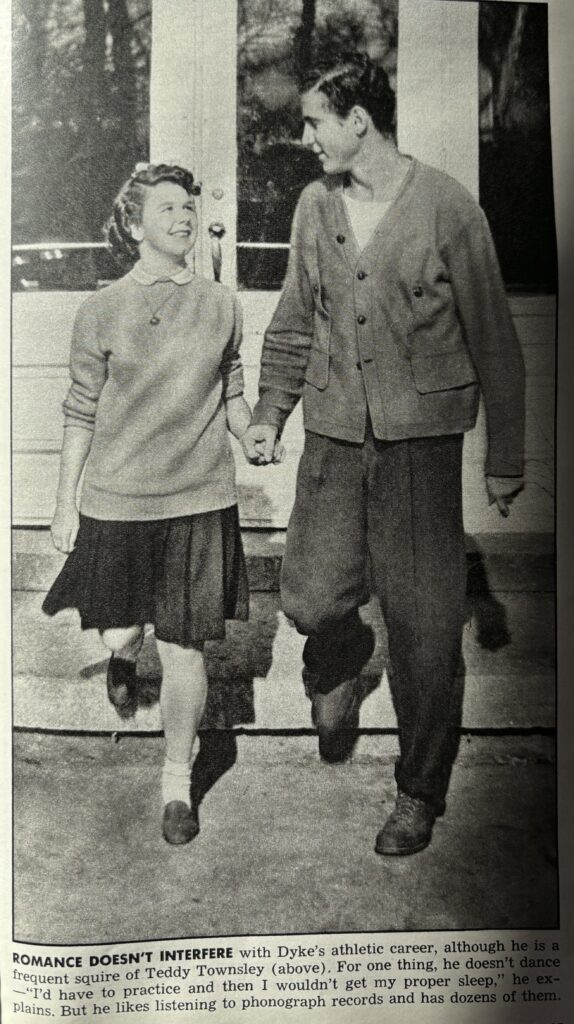
The kiss shot was so unusual few other Illinois coaches taught or emphasized it, although several non-Centralia players learned how to shoot it on their own. I could find only two other Illinois schools reporting that they used the technique. Greenville High School employed “a modified kiss-shot from far out on the court,” in 1943, and the Vandalia squad used “the kiss shot like Centralia” in the 1947-1948 season. Several Illinois colleges, however, saw the benefits of having a Centralia kiss-shot artist during this time. Newspaper articles announced that Illinois State University, Southern Illinois University, Illinois Wesleyan, and Carthage College all offered kiss shot “testimonials.” In one instance, the shooting style was used out of state. In 1948, an Iowa girls’ high school basketball player, Betty Armstrong at Wiota High School, became known for “her famous ‘kiss shots.’” One reporter gushed, “She is almost a cinch for two points when she gets set and shoots,”
But there were plenty of critics of the shot at this time too.
One Illinois sportswriter pointed out how the shot did not work in the smaller gyms of that day. He reported, “The familiar spectacle of an effortlessly arching famed Centralia ‘kiss shot’ swishing nimbly through the hoop was grounded by the low ceiling of girders.” Another reporter asserted, “Fans sometimes forget the misses when a few long heaves pay off.” He further complained, after a Centralia loss, that the team, “made only six of 41 shots in the second and third periods, three or four kiss shots from the corner, but not one from out in front.”
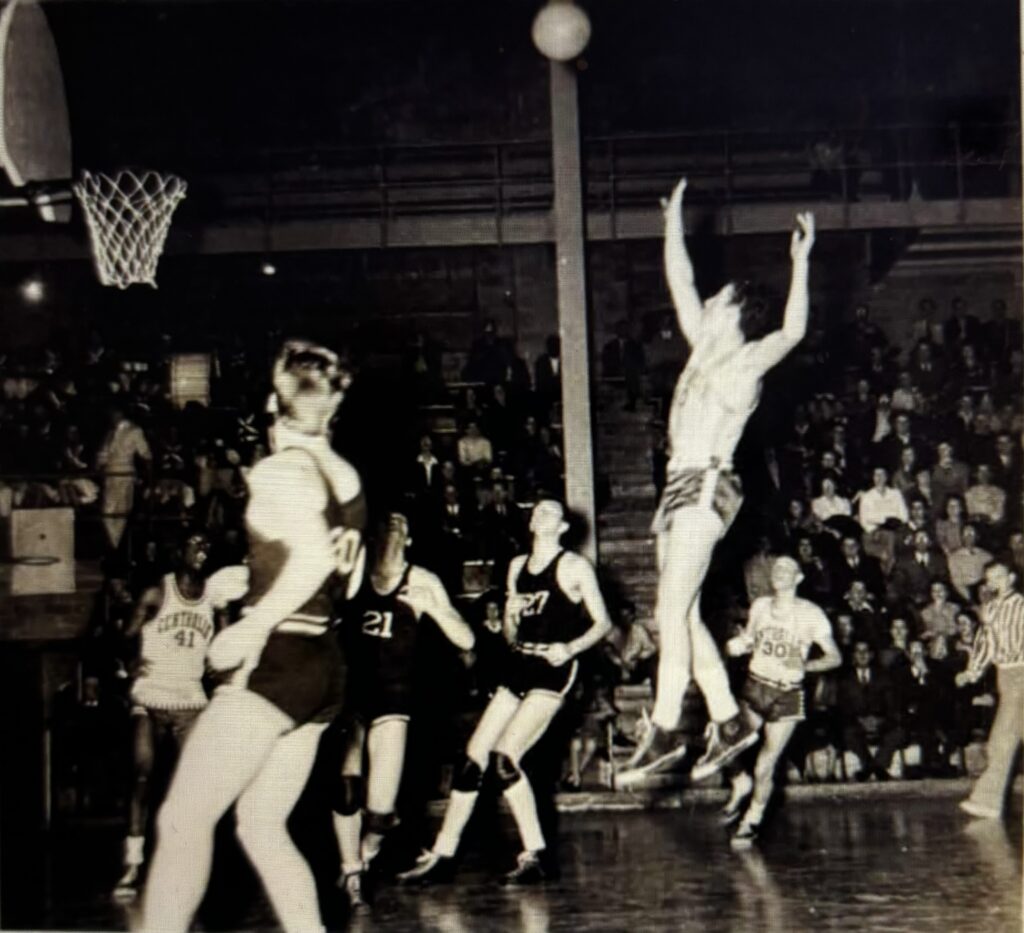
Most of the time the shot worked. One Illinois newspaper summed it up this way, “There’s no question but that Centralia has the most unorthodox team but those familiar with Centralia’s basketball in the past years would notice nothing strange about those long tosses.” Another sports reporter added, “Shooting away up in the air, in the rafters. Old fashioned, you may say, but the grand old man of southern Illinois is getting results, and that’s what they pay off on.” Trout’s coaching career at Centralia High School witnessed 809 victories, ten state tournament teams, and three state championships. His teams won twenty-five games during fifteen different seasons while grabbing more than sixty-five championship trophies. For many years after his retirement, he was the winningest high school coach in Illinois and the nation.
But all his success could not save his beloved kiss shot.
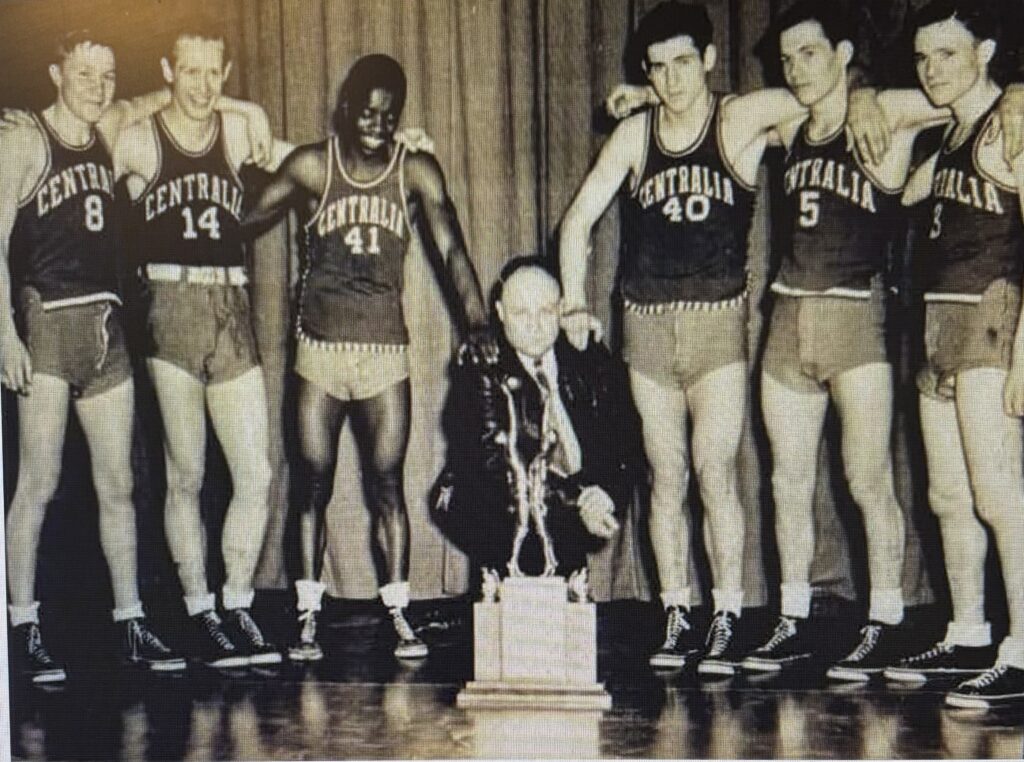
It was after Trout retired in 1950 that the era of the kiss shot began to fade. Throughout the 1950s, Centralia teams continued to use the shot to some extent and a few other non-Centralia players, like Herrin’s Richard “Itchy” Jones, did as well. The shot also turned up occasionally in grade school play reports. The last comment in a high school sports article about the technique that I found talked about a Centralia loss in 1959, when Rod Linder had southern Illinois fans “buzzing over the terrific performance of ‘kiss’ shots.”
Meanwhile, Southern Illinoisan sportswriter Merle Jones may have been the first to sing the praises of a new coach in the region in 1950, one who taught his players more modern styles of shooting. Jones wrote glowingly of Mt. Vernon Rams coach Stan Changnon who led his team to an undefeated season and a state championship that year. The squad was crowned by sportswriters as the greatest Illinois high school basketball team ever. Jones, for his part, raved about the Rams. It seemed too, an indirect slap at Trout’s kiss shot.
I never saw a team anywhere with shots that the Rams shoot. Every boy on the team fired his set shot by holding the ball over his head. The shot was not as spectacular as Arthur Trout’s kiss shot, but the only reason was that the Rams did not fire from such a long distance. Certainly, the shot was as deadly as any shot you ever saw. I never saw a team on which every man was trained to face the basket, jump and shoot a one-handed shot practically impossible to guard. The Rams to a man shot the overhead shot when they were not guarded and fired their jump shot when a guard was nearby. These two shots were particular only when you saw the Rams play. To my knowledge no other team in the state follows such a shooting pattern. Stan taught the boys that system.
Merle Jones’ 1950 observation would eventually lead to sportswriter Rich Underwood asking in 1996 if “long time Mount Vernon coach Stanley Changnon invented the one-handed jump shot.” It was an interesting possibility. There had been individual players scattered across the country who shot some form of the modern jump shot, maybe as early as 1935. But Changnon may have been one of the first coaches ever to teach a true jump shot in a methodical way to a specific group of players. As Jones noted, he did not see the shot attempted in any of the games he watched in Illinois during the 1949-1950 season. A photo of Changnon’s best player in 1950, Max Hooper, taking what looks like a modern jump shot helps make the case as well.
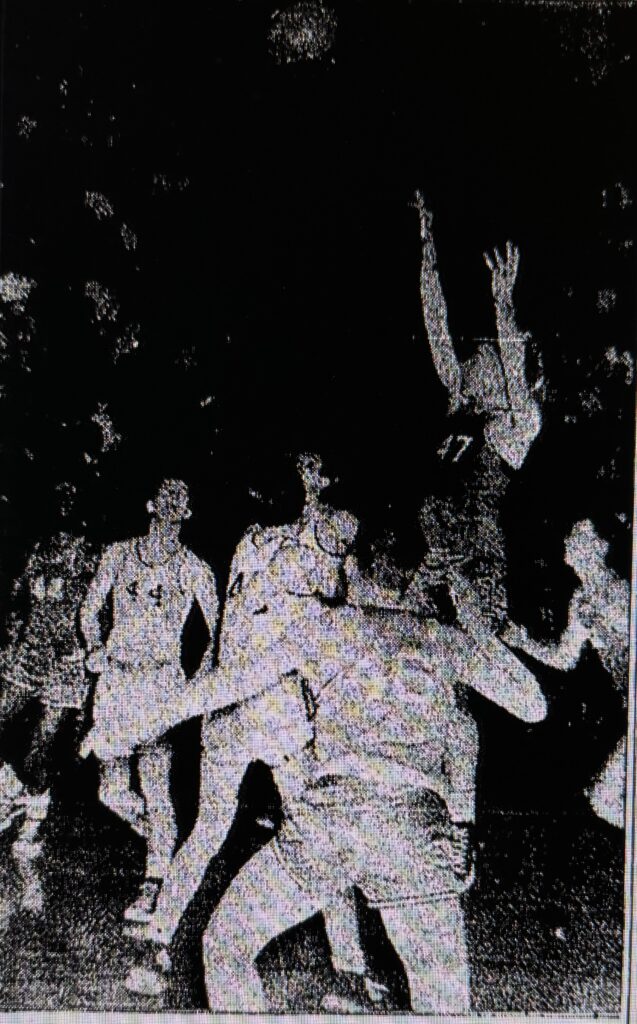
Ironically, Arthur Trout’s kiss shot gained a new life throughout the 1950s as Illinois players went out to play college ball in Illinois and all over the nation. Southern Illinois University certainly had its share of “kiss-shot artists.” Itchy Jones, for example, made four straight kiss shots in a row in a win over the University of North Dakota. The University of California raved about Larry Friend in 1954 who “throws the Illinois kiss shot from outside so effectively.” One newspaper noted that seven foot San Francisco University player Wilt Chamberlain “could not prevent Friend from getting off his high-arched shots from beyond the key.” Ron Whimpy, a Centralia high school star, was remembered at East Texas Baptist College for his kiss shot, what they noted as an “unorthodox shooting ability” in 1955. That same year, a Texas newspaper explained a kiss shot “starts near a player’s face and his hands spread after the ball is shot like he had kissed it goodbye.” It was Dike Eddelman, however, who did the most to keep the shot on life-support for a brief while.
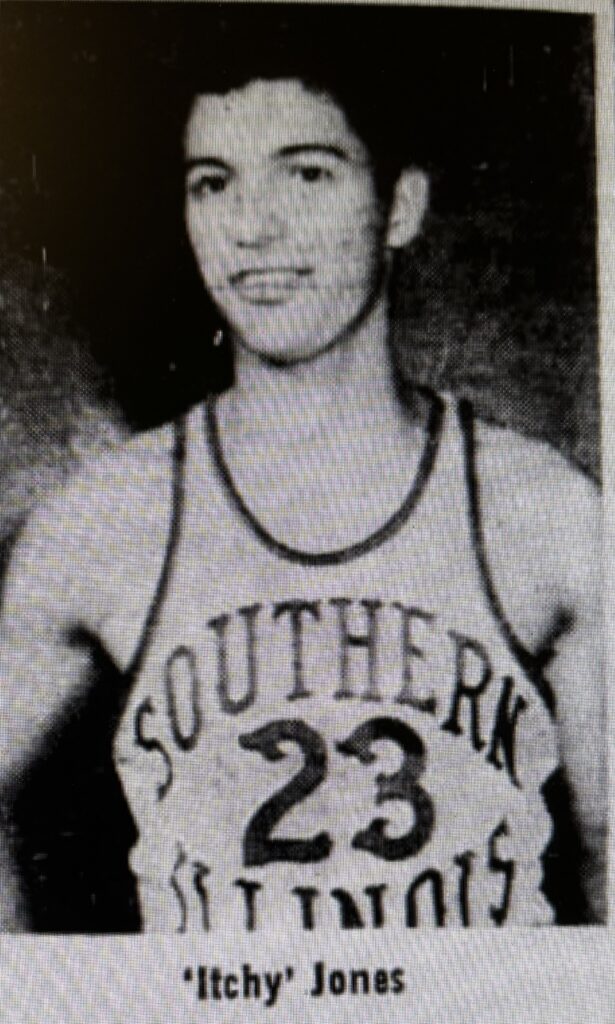
A football, track, and basketball star at the University of Illinois, Eddelman’s shooting style created a stir in Big Nine (later Big Ten) play in 1948. An Indiana newspaper sports reporter noted that “the formal and informal interpretations of how to shoot a basketball through a hoop will be displayed before 15,000 spectators Monday night when Illinois plays at Iowa.”
Eddelman, the writer went on to explain, “Uses the kiss shot. He is the leading exponent of it in the Big Nine. In fact, he may be the only man in the conference who uses it.”
There was great disagreement among Big Nine coaches regarding the shot. Many did not like it because they believed college guards were bigger, smarter, and quicker than those in high school and the stance of the kiss shot artist slowed down his moves and limited him to just shooting once he went into the proper stance. A few agreed with Coach Trout’s thinking, believing that looking over the top of the basketball before shooting aimed the shot, like aiming a rifle by looking down the top of the barrel. It was appropriate that Dike’s last basket he scored at Illinois was a thunderous 40 foot kiss shot.
After college, Eddelman took the shooting style to the National Basketball League where his kiss shot again entertained fans in a big way. A Rock Island, Illinois, Argus sportswriter wrote that there wasn’t much the opposition could do once “Eddelman gets the sights aligned for his famous ‘kiss shot.’” In 1950, he broke the single game scoring record held by George Mikan, hitting 48 points, many coming off the shot he had learned from Coach Arthur Trout at Centralia. Before his brief career ended, he was known as the “man with the long ‘kiss-shot.’” Dike retired in 1954 from professional basketball. And the kiss-shot fell off the radar.
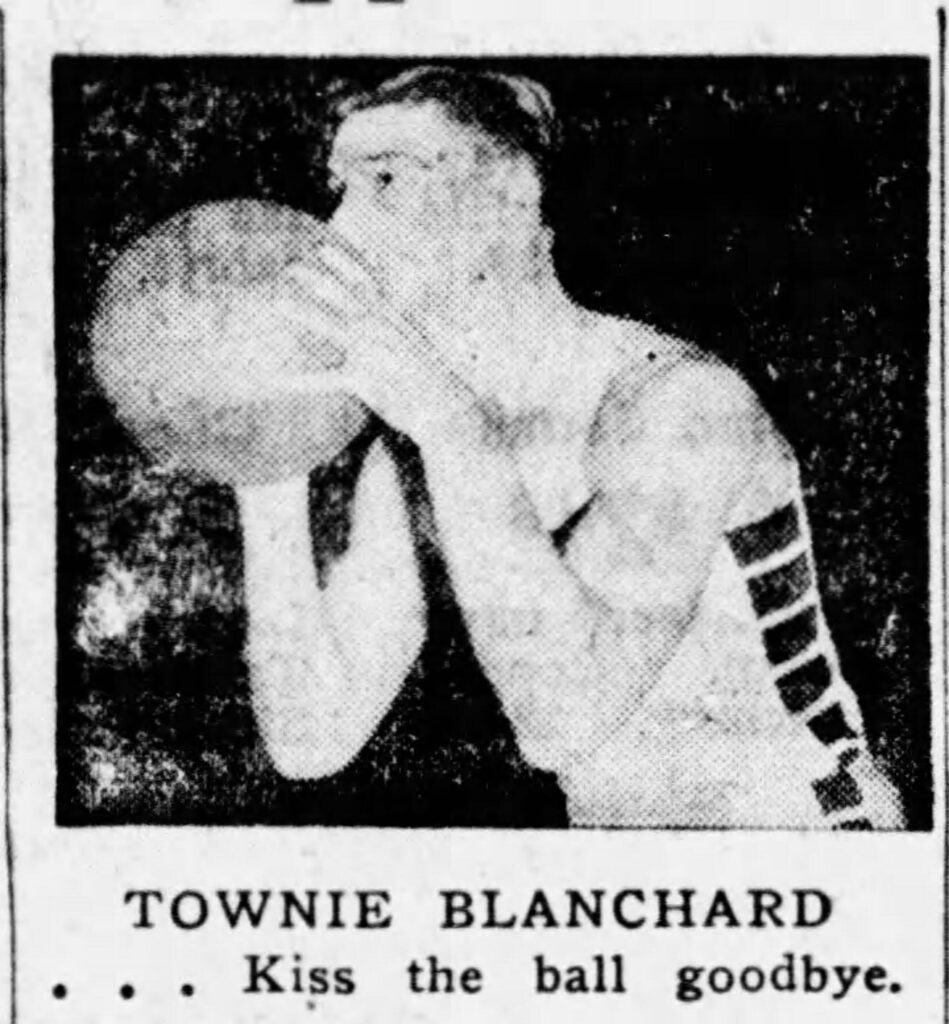
________________________________________
One last thing. When I finished the story, I felt disappointed. Like I was back at my old dirt basketball court trying to get Dad to give me more information about the kiss shot. I was unable to identify when and where the very last one may have taken place. I wanted perfect closure, like the thunderous slamming of the nets when a kiss shot finds it mark.
Eddelman had retired in 1954. Kiss shot artist Ron Whimpy had ended his college career in Texas in 1955. Had Texas been the site of the very last kiss shot, the last of its kind? But then I remembered Ron Linder’s high school kiss shot spree in 1959.
There was another frustration. I had not been able to find a single action shot of a player letting go a Centralia kiss shot. I only had the vision of my dad throwing the ball up to the goal on the home-made court of my childhood. Then like a blessing I did not deserve; I was searching through newspapers from the late sixties when my “kiss shot” descriptor hit pay dirt. Still, I didn’t think it would tell me much. Probably some old sports reporter going down memory lane.
I started to read the article. It did not sound hopeful. The Gibson City, Illinois, high school lettermen were hosting a basketball game to raise money for the school’s athletic programs. The visiting team was the Texas Cowgirls. They would be going up against some local guys, some young and several not so young. Then, at the very end, I read about the last score of the game, “a soaring shot from way out on the court, the ball just missing rafters and lights, and making just one sound— swish.” And then I read who made what might have been the last kiss shot. I could hardly believe it, Dike Eddelman, “just letting fly one of those kiss shots.” And there was a picture too, dark, and grainy, but you could see the release, just like Dad’s that day he demonstrated the shot. PERFECT.
